
Japan’s Immigration Surge, a Policy Reckoning Ahead
Introduction: A Nation at a Crossroads
Everyone who lives in Japan, or visited for an extended period, knows that Japan is at a demographic precipice. With a declining population and one of the world’s oldest societies, the government has turned—sometimes quietly, often reluctantly—to immigration as a means of national survival. This article explores the scope, complexity, and consequences of Japan’s evolving immigration landscape, weaving in recent data, trends, and public reactions across regions and sectors. It should answer questions you might already have.
The Surge in Foreign Residents
Japan’s foreign resident population reached a historic high in 2024, exceeding 3.77 million people. The figure represents a 10.5% increase from 2023… and that is a lot. This growth is driven by industry demands and regional labor shortages. In fact, foreign nationals now account for one in every 34 residents—a quiet but unmistakable transformation in a country long known for its ethnic homogeneity… and insularity.
This immigration growth is distinctly NOT due to digital nomads, whose blip doesn’t even register on the radar. There is a global sense of “Japan is cool” which of course translates into thousands of short-term and long-term explorers. In 2024, Japan even created a special visa for digital nomads. Too early to calibrate their impact yet, but it is a factor in the overall immigration mix.
Gender Composition of Immigration (2019–2023)
The past five years has seen a steady increases in both male and female migrants, displaying some notable trends: Filipinas dominate caregiving and domestic sectors, Vietnamese males cluster in construction and agriculture, while Indonesians show a balanced gender distribution due to the rise of both technical and nursing tracks.
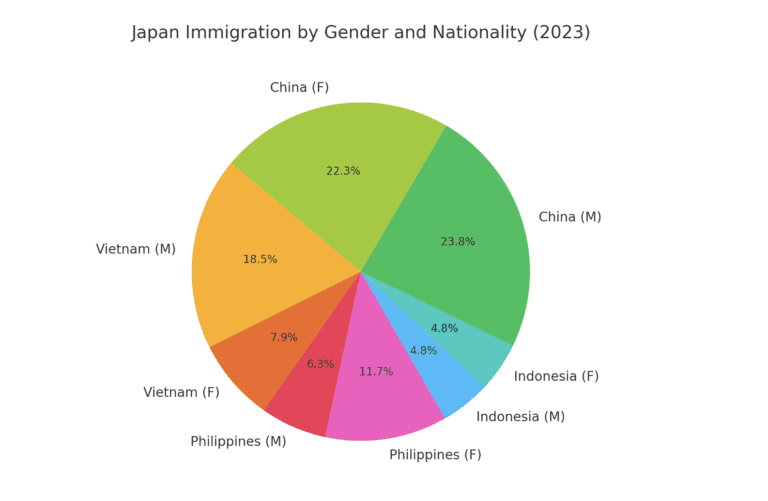
Country of Origin: A Diverse Influx
The top countries of origin for foreign residents are China (873,000), Vietnam (634,000), South Korea (409,000), the Philippines (341,000), and Nepal (233,000). Each group brings their own distinct labor, cultural, and demographic footprint. While Chinese migrants span business, family, and education visas, Vietnamese and Nepalese are heavily concentrated in blue-collar and intern training roles.
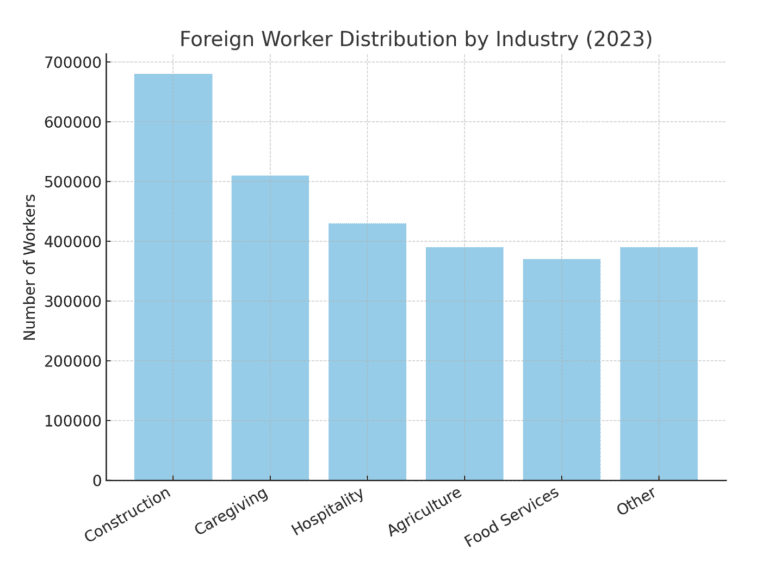
Regional Distribution: Urban Centers and Rural Dependencies
Tokyo, Osaka, and Aichi prefectures host the largest absolute numbers of foreign nationals. However, rural prefectures like Yamagata, Niigata, and parts of Kyushu show the most dramatic proportional increases—particularly due to agricultural and fishery demands. In these areas, foreign workers are often the sole lifeline keeping small farms and local services operational. This is pretty astounding.
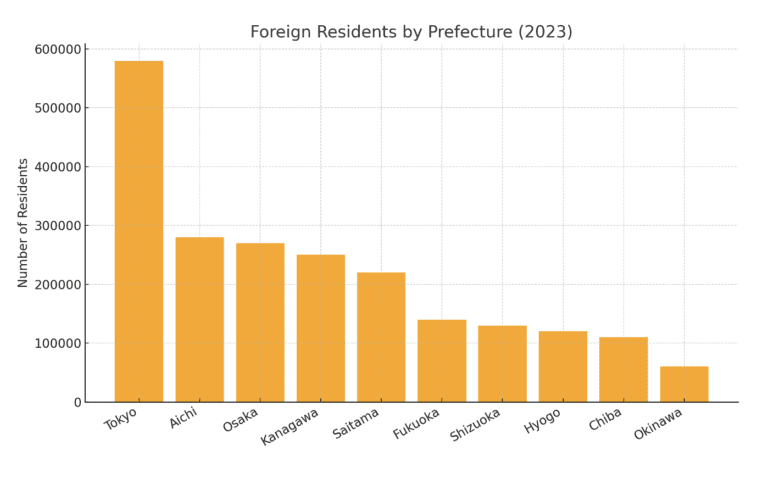
Industry Integration: Foreign Workers Filling the Gaps
Sectors most reliant on foreign labor include construction, agriculture, fisheries, hospitality, caregiving, and food services. In hospitals and eldercare, foreign women—especially from the Philippines and Indonesia—are vital. In construction and logistics, male labor from Vietnam, Nepal, and Myanmar predominates.
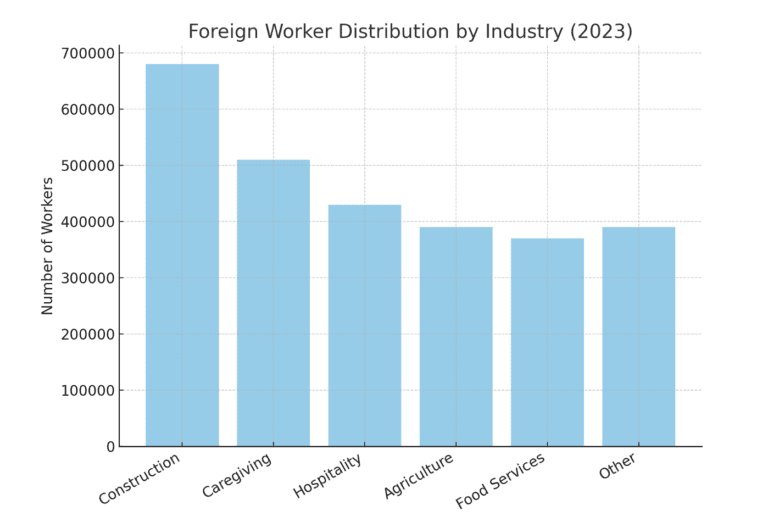
Visa Overstays: A Growing Concern
While most foreign workers comply with legal terms, the number of visa overstays in 2023 rose by 9.6% to approximately 80,000 individuals. Vietnamese nationals comprise a disproportionately large share of these overstays, reflecting exploitation, debt, and breakdowns in the Technical Intern Training Program.
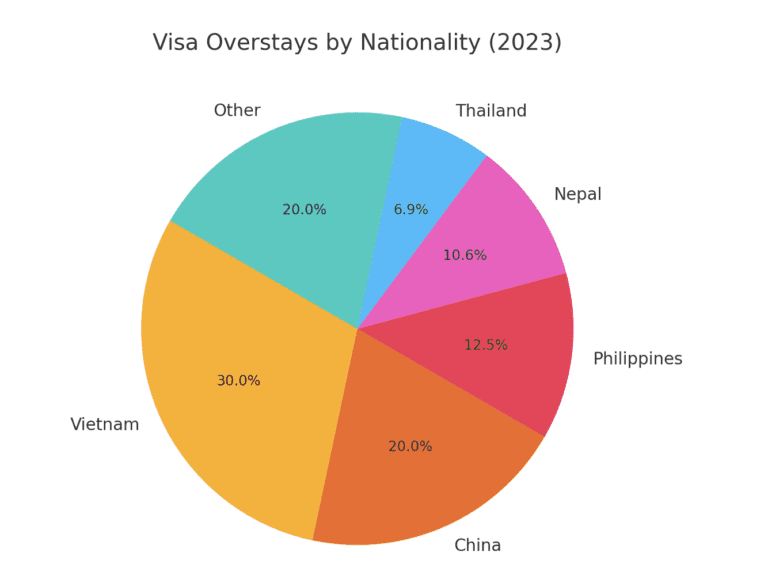
International Students: Education and Retention
Japan welcomed over 280,000 foreign students in 2024. However, only 33% of them remain in Japan after graduation. Many return home or move to other countries due to language barriers, wage gaps, or social exclusion. This low retention rate raises further questions about Japan’s long-term talent strategy and integration capacity.
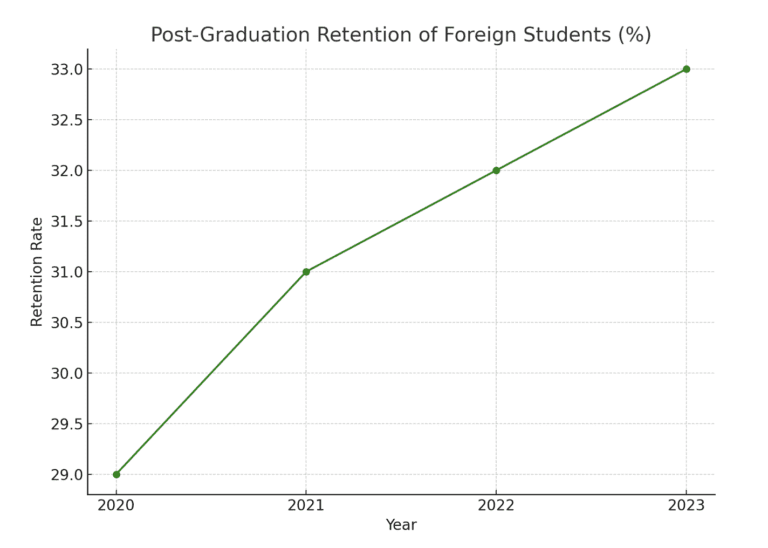
While the current retention rate may appear modest, it reflects a meaningful improvement over the past two decades—up from just 19.7% in 2004. This rise is no accident.
Over the last decade, Government of Japan policy has quietly but deliberately shifted to encourage international graduates to remain. A key change, for example, was the introduction of “Designated Activities” visa. This grants a graduate to remain, up to one year (renewable once) for job-seeking. More recently, a J-FIND visa further expanded options by allowing top university graduates to remain in Japan without a sponsor, targeting entrepreneurial or self-directed talent. Even more impactfully, financial support has grown. too: the Japan Student Services Organization (JASSO) now provides cash stipends, subsidized housing, and tuition discounts through national and institutional scholarship schemes.
This multi-pronged effort reflects Japan’s growing recognition that its shrinking workforce cannot be sustained without foreign talent—and that retention begins well before graduation. Still, as the chart above suggests, the pace of progress remains gradual, constrained by cultural frictions, wage disparities, and persistent structural inertia.
Remittances: Economic Ties Beyond Borders
Japan is now one of the top 10 remittance-sending countries globally. In 2023 alone, foreign workers in Japan sent over ¥700 billion (US$4.47 billion) back to their home countries: that is about 8.8% of Japan’s total defense budget for fiscal 2024. The Philippines, Vietnam, and Nepal were the largest recipients—revealing how Japan’s internal labor economy is deeply tied to regional development across Asia.
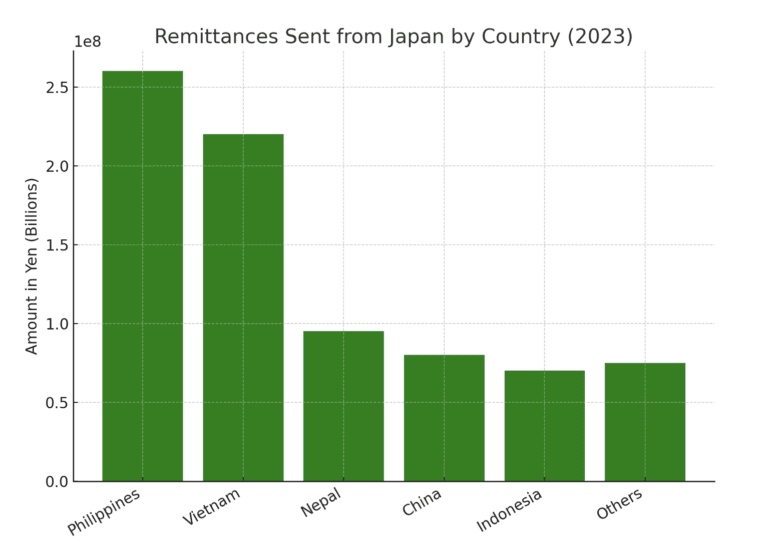
Cultural Footprints: Ethnic Enclaves and Daily Life
From halal restaurants in Saitama to Chinese supermarkets in Yokohama (largest Chinatown in Asia), ethnic businesses are transforming Japan’s culinary and retail landscape. Local shopping streets and convenience stores increasingly cater to foreign tastes and traditions. Yet this change is uneven, with some communities embracing it—and others expressing unease.
Crime, Perception, and Profiling
Although foreign crime rates are statistically low, media and political narratives often amplify isolated incidents in some situations, totally ignore it in others. In 2023, theft, overstays, and employment violations topped foreign-related offenses. A January 2024 lawsuit against police profiling sparked public debate, revealing systemic targeting of Southeast Asians and Africans in particular. This perception gap underscores the urgent need for inclusive dialogue and community-building.
At the same time, however, there have been organized as well as sporadic thefts of calves, livestock, whole nurseries of plants, copper cables and high-end automobiles. Except for those affiliated with the home-grown criminal element of Japanese society, most Japanese are shocked at these brazen thefts, and so foreigners are often blamed. Unmistakably (though the statistics are hard to come by), the foreign element has an impact on the crime-rate.
Special Cases and Social Friction
More visible, perhaps, are the breaches of social norms and disruption of the natural flow. For example, tourists taking photos of Mt. Fuji and leaving a mess, or flocking to a scene from a famous movie and causing congestion. Shibuya Scramble is a fairly prominent example of this.
Or more dramatically in Okinawa, local outrage has mounted over Chinese acquisitions of land near military zones. The Japanese government now restricts (codified in law now) foreign ownership of property within designated distances of ‘sensitive areas.’
Urban elites, meanwhile, are confronting cultural tensions of a different sort—such as at the highly vaulted Tokyo American Club. Here, long-term Members are increasingly raising concerns over noise and etiquette from newly admitted foreign elites, especially from mainland China. Elsewhere, for example in rural Japan, another rumor persists that Chinese investors have quietly bought up rights to fresh water sources. While legally difficult, purchases of land around springs, aquifers & mountain streams have fueled this fear—and the perception is nearly as impactful as the reality. Urban legends play a part in the growing difficulty of assimilating foreigners into Japanese society.
Policy Implications: A Nation in Transition
Japan cannot turn back the demographic clock. They tried… paying for education, paying birthing fees, cash awards for having your second or third child! Then it was women: incorporate more of them into the workplace: set numerical standards for Boardroom inclusion, or quota for elevation to the manager-class, or providing more parental-leave to take care of one’s children or, more frequently, one’s aging parents. These efforts are too little, too late: the crunch is upon the country now.
The question is not whether immigration will reshape the country—but how wisely that transition is managed. A proactive approach—centered on humane integration, transparent regulation, and public education—is essential. Ignoring this shift risks fueling nationalism, division, and economic stagnation.
Conclusion
Immigration is no longer a side story in Japan—it is the main plot. Quietly, steadily, the country is becoming more diverse, more porous, and more reliant on the labor and lives of people from all over the world. Policy must catch up to this reality—not just to preserve social harmony, but to ensure Japan’s resilience in the 21st century.
Are you familiar with “Tokyo on Fire”? Episodes are available on YouTube “Langley Esquire”: excruciatingly-gained insights sifted over 40 years in-country! Entertainingly presented.
“Japanese Politics One-on-One” episodes are on YouTube “Japan Expert Insights”.
If you gain insight from these briefings, consider a tailored one for your Executive Team or for passing-through-Tokyo heavyweights.
To learn more about advocacy in Japan, read our article “Understanding the Dynamics of Lobbying in Japan.”
Join the Success!
Experience exceptional, personalized solutions designed to meet your business’s specific needs. Discover how we can elevate your operations to the next level.
